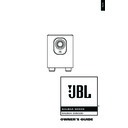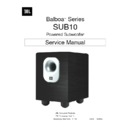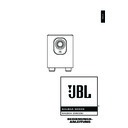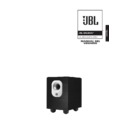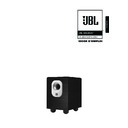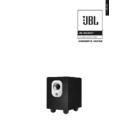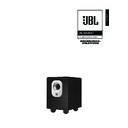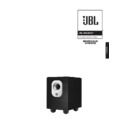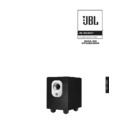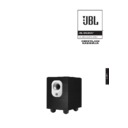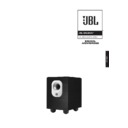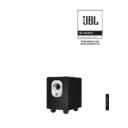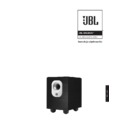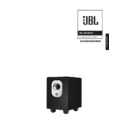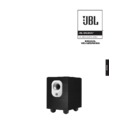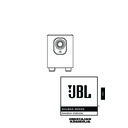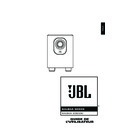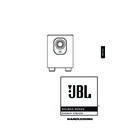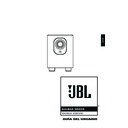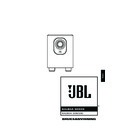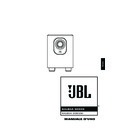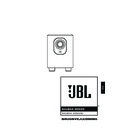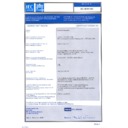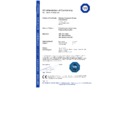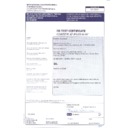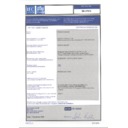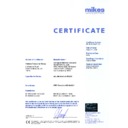JBL BALBOA SUB (serv.man8) User Manual / Operation Manual ▷ View online
English
BALBOA SUB/230
BALBOA SERIES
OWNER’S GUIDE
®
2
READ FIRST!
Important Safety Precautions!
1. Read these instructions.
2. Keep these instructions.
3. Heed all warnings.
4. Follow all instructions.
5. Do not use this apparatus near
water.
6. Clean only with a dry cloth.
7. Do not block any ventilation
openings. Install in accordance with
the manufacturer’s instructions.
8. Do not install near any heat
sources such as radiators, heat reg-
isters, stoves or other apparatus
(including amplifiers) that produce
heat.
9. Do not defeat the safety purpose
of the polarized or grounding-type
plug. A polarized plug has two
blades with one wider than the
other. A grounding-type plug has
two blades and a third grounding
prong. The wide blade or the third
prong are provided for your safety. If
the provided plug does not fit into
your outlet, consult an electrician
for replacement of the obsolete
outlet.
10. Protect the power cord from
being walked on or pinched, particu-
larly at plugs, convenience recepta-
cles and the point where they exit
from the apparatus.
11. Only use attachments/acces-
sories specified by the manufac-
turer.
12. Use only with the cart,
stand, tripod, bracket or
table specified by the
manufacturer or sold
with the apparatus. When a
cart is used, use caution when mov-
ing the cart/apparatus combination
to avoid injury from tip-over.
2. Keep these instructions.
3. Heed all warnings.
4. Follow all instructions.
5. Do not use this apparatus near
water.
6. Clean only with a dry cloth.
7. Do not block any ventilation
openings. Install in accordance with
the manufacturer’s instructions.
8. Do not install near any heat
sources such as radiators, heat reg-
isters, stoves or other apparatus
(including amplifiers) that produce
heat.
9. Do not defeat the safety purpose
of the polarized or grounding-type
plug. A polarized plug has two
blades with one wider than the
other. A grounding-type plug has
two blades and a third grounding
prong. The wide blade or the third
prong are provided for your safety. If
the provided plug does not fit into
your outlet, consult an electrician
for replacement of the obsolete
outlet.
10. Protect the power cord from
being walked on or pinched, particu-
larly at plugs, convenience recepta-
cles and the point where they exit
from the apparatus.
11. Only use attachments/acces-
sories specified by the manufac-
turer.
12. Use only with the cart,
stand, tripod, bracket or
table specified by the
manufacturer or sold
with the apparatus. When a
cart is used, use caution when mov-
ing the cart/apparatus combination
to avoid injury from tip-over.
13. Unplug this apparatus during
lightning storms or when unused for
long periods of time.
14. Refer all servicing to qualified
service personnel. Servicing is
required when the apparatus has
been damaged in any way, such
as power-supply cord or plug is
damaged, liquid has been spilled
or objects have fallen into the
apparatus, the apparatus has been
exposed to rain or moisture, does
not operate normally, or has been
dropped.
15. Do not use attachments not
recommended by the product
manufacturer, as they may cause
hazards.
16. This product should be operated
only from the type of power source
indicated on the marking label. If
you are not sure of the type of
power supply to your home, consult
your product dealer or local power
company. For products intended to
operate from battery power, or other
sources, refer to the operating
instructions.
17. If an outside antenna or cable
system is connected to the product,
be sure the antenna or cable system
is grounded so as to provide some
protection against voltage surges
and built-up static charges. Article
810 of the National Electrical Code,
ANSI/NFPA 70, provides
information with regard to proper
grounding of the mast and support-
ing structure, grounding of the lead-
in wire to an antenna discharge unit,
size of grounding conductors, loca-
tion of antenna-discharge unit, con-
nection to grounding electrodes,
and requirements for the grounding
electrode. See Figure A.
18. An outside antenna system
should not be located in the vicinity
of overhead power lines or other
electric light or power circuits, or
where it can fall into such power
lightning storms or when unused for
long periods of time.
14. Refer all servicing to qualified
service personnel. Servicing is
required when the apparatus has
been damaged in any way, such
as power-supply cord or plug is
damaged, liquid has been spilled
or objects have fallen into the
apparatus, the apparatus has been
exposed to rain or moisture, does
not operate normally, or has been
dropped.
15. Do not use attachments not
recommended by the product
manufacturer, as they may cause
hazards.
16. This product should be operated
only from the type of power source
indicated on the marking label. If
you are not sure of the type of
power supply to your home, consult
your product dealer or local power
company. For products intended to
operate from battery power, or other
sources, refer to the operating
instructions.
17. If an outside antenna or cable
system is connected to the product,
be sure the antenna or cable system
is grounded so as to provide some
protection against voltage surges
and built-up static charges. Article
810 of the National Electrical Code,
ANSI/NFPA 70, provides
information with regard to proper
grounding of the mast and support-
ing structure, grounding of the lead-
in wire to an antenna discharge unit,
size of grounding conductors, loca-
tion of antenna-discharge unit, con-
nection to grounding electrodes,
and requirements for the grounding
electrode. See Figure A.
18. An outside antenna system
should not be located in the vicinity
of overhead power lines or other
electric light or power circuits, or
where it can fall into such power
lines or circuits. When installing an
outside antenna system, extreme
care should be taken to keep from
touching such power lines or circuits,
as contact with them might
be fatal.
19. Do not overload wall outlets,
extension cords, or integral
convenience receptacles, as this
can result in a risk of fire or
electric shock.
20. Never push objects of any kind
into this product through openings,
as they may touch dangerous volt-
age points or short-out parts that
could result in a fire or electric
shock. Never spill liquid of any kind
on the product.
21. The apparatus shall not be
exposed to dripping or splashing,
and no objects filled with liquids,
such as vases, shall be placed on
the apparatus.
22. Do not attempt to service this
product yourself, as opening or
removing covers may expose you to
dangerous voltage or other hazards.
Refer all servicing to qualified ser-
vice personnel.
23. When replacement parts are
required, be sure the service tech-
nician has used replacement parts
specified by the manufacturer or
that have the same characteristics
as the original part. Unauthorized
substitutions may result in fire, elec-
tric shock or other hazards.
24. Upon completion of any service
or repairs to this product, ask the
service technician to perform safety
checks to determine that the prod-
uct is in proper operating condition.
25. The product should be mounted
to a wall or ceiling only as recom-
mended by the manufacturer.
outside antenna system, extreme
care should be taken to keep from
touching such power lines or circuits,
as contact with them might
be fatal.
19. Do not overload wall outlets,
extension cords, or integral
convenience receptacles, as this
can result in a risk of fire or
electric shock.
20. Never push objects of any kind
into this product through openings,
as they may touch dangerous volt-
age points or short-out parts that
could result in a fire or electric
shock. Never spill liquid of any kind
on the product.
21. The apparatus shall not be
exposed to dripping or splashing,
and no objects filled with liquids,
such as vases, shall be placed on
the apparatus.
22. Do not attempt to service this
product yourself, as opening or
removing covers may expose you to
dangerous voltage or other hazards.
Refer all servicing to qualified ser-
vice personnel.
23. When replacement parts are
required, be sure the service tech-
nician has used replacement parts
specified by the manufacturer or
that have the same characteristics
as the original part. Unauthorized
substitutions may result in fire, elec-
tric shock or other hazards.
24. Upon completion of any service
or repairs to this product, ask the
service technician to perform safety
checks to determine that the prod-
uct is in proper operating condition.
25. The product should be mounted
to a wall or ceiling only as recom-
mended by the manufacturer.
Figure A.
Example of Antenna Grounding as
per National Electrical Code,
ANSI/NFPA 70
Example of Antenna Grounding as
per National Electrical Code,
ANSI/NFPA 70
SPEAKER PLACEMENT
• As a general rule, bass
response increases as a sub-
woofer is placed closer to a
wall. Therefore, bass output
is maximized when the sub-
woofer is placed in a corner.
woofer is placed closer to a
wall. Therefore, bass output
is maximized when the sub-
woofer is placed in a corner.
• It is also recommended that
the subwoofer be positioned
along the same wall as the
front loudspeakers.
along the same wall as the
front loudspeakers.
Low-frequency sounds are
normally omnidirectional,
meaning the listener can’t tell
where they are generated
from. However, frequencies
between 75Hz and 150Hz can
be localized, especially at
higher volume levels. Position-
ing your subwoofer as recom-
mended will provide the most
natural soundstage and
imaging from your loudspeaker
system.
normally omnidirectional,
meaning the listener can’t tell
where they are generated
from. However, frequencies
between 75Hz and 150Hz can
be localized, especially at
higher volume levels. Position-
ing your subwoofer as recom-
mended will provide the most
natural soundstage and
imaging from your loudspeaker
system.
Remember that these are just
guidelines. Since every listen-
ing room is different, JBL
guidelines. Since every listen-
ing room is different, JBL
strongly recommends experi-
menting with the positioning of
your subwoofer to obtain the
most pleasing results in your
room. One technique that can
help you find the ideal sub-
woofer location is to temporar-
ily place the subwoofer near
the main listening location.
Then move around the room
and determine where you hear
the most pleasing bass perfor-
mance. This would then be the
ideal location for the sub-
woofer.
menting with the positioning of
your subwoofer to obtain the
most pleasing results in your
room. One technique that can
help you find the ideal sub-
woofer location is to temporar-
ily place the subwoofer near
the main listening location.
Then move around the room
and determine where you hear
the most pleasing bass perfor-
mance. This would then be the
ideal location for the sub-
woofer.
SPEAKER CONNECTION
When we designed the Balboa
Sub powered subwoofer, our
goal was to offer the user the
best possible performance
combined with the most flexi-
ble and complete installation
options. Please look over the
following three examples to
determine which description
best matches your system and
follow the corresponding
hookup instructions.
Sub powered subwoofer, our
goal was to offer the user the
best possible performance
combined with the most flexi-
ble and complete installation
options. Please look over the
following three examples to
determine which description
best matches your system and
follow the corresponding
hookup instructions.
To use the binding-post
speaker terminals with bare
wire, unscrew the collar until
the hole through the center
post is visible under the collar.
Insert the bare end of the wire
through the hole in the post,
then screw the collar back
speaker terminals with bare
wire, unscrew the collar until
the hole through the center
post is visible under the collar.
Insert the bare end of the wire
through the hole in the post,
then screw the collar back
down until the connection is
tight. The holes in the center of
the collars are intended for
banana-type connectors.
tight. The holes in the center of
the collars are intended for
banana-type connectors.
Speakers and electronics ter-
minals have corresponding
positive (+) and negative (–)
terminals. It is important to
connect both speakers identi-
cally: positive (+) on the
minals have corresponding
positive (+) and negative (–)
terminals. It is important to
connect both speakers identi-
cally: positive (+) on the
speaker to positive (+) on the
amplifier and negative (–) on
the speaker to negative (–) on
the amplifier. Wiring “out of
phase” results in thin sound,
weak bass and a poor stereo
image.
amplifier and negative (–) on
the speaker to negative (–) on
the amplifier. Wiring “out of
phase” results in thin sound,
weak bass and a poor stereo
image.
With the advent of multichan-
nel surround sound systems,
connecting all of the speakers
in your system with the correct
polarity remains equally impor-
tant in order to preserve the
proper ambience and direc-
tionality of the program
material.
nel surround sound systems,
connecting all of the speakers
in your system with the correct
polarity remains equally impor-
tant in order to preserve the
proper ambience and direc-
tionality of the program
material.
3
English
THANK YOU FOR CHOOSING JBL
For more than 50 years, JBL
has been involved in every
aspect of music and film
recording and reproduction,
from live performances to the
recordings you play in your
home, car or office.
has been involved in every
aspect of music and film
recording and reproduction,
from live performances to the
recordings you play in your
home, car or office.
We’re confident that the JBL
system you have chosen will
provide every note of enjoy-
system you have chosen will
provide every note of enjoy-
ment that you expected – and
that when you think about pur-
chasing additional audio
equipment for your home, car
or office, you will once again
choose JBL.
that when you think about pur-
chasing additional audio
equipment for your home, car
or office, you will once again
choose JBL.
Please take a moment to regis-
ter your product on our Web
site at www.jbl.com.
ter your product on our Web
site at www.jbl.com.
This enables us to keep you
posted on our latest advance-
ments, and helps us to better
understand our customers and
build products that meet their
needs and expectations.
posted on our latest advance-
ments, and helps us to better
understand our customers and
build products that meet their
needs and expectations.
JBL Consumer Products
4
DOLBY PRO LOGIC* (NON-DIGITAL) – LINE LEVEL
Use this installation method for
Dolby Pro Logic applications
(not Dolby Digital, DTS or other
digital processing), where the
receiver/processor is
equipped with a subwoofer
output, or a volumecontrolled
preamp (line-) level output:
Dolby Pro Logic applications
(not Dolby Digital, DTS or other
digital processing), where the
receiver/processor is
equipped with a subwoofer
output, or a volumecontrolled
preamp (line-) level output:
Use RCA-type interconnects to
connect the line-level sub-
woofer outputs on your recei-
ver or amplifier to the line-level
inputs on the subwoofer.
connect the line-level sub-
woofer outputs on your recei-
ver or amplifier to the line-level
inputs on the subwoofer.
IMPORTANT: Do not use the
LFE input on the subwoofer
with Dolby Pro Logic proces-
sors.
LFE input on the subwoofer
with Dolby Pro Logic proces-
sors.
NOTE: If your receiver or
amplifier only has one sub-
woofer output jack, then you
will need to use a Y-connector
(not included).
amplifier only has one sub-
woofer output jack, then you
will need to use a Y-connector
(not included).
Plug the male end of the Y-
connector into your receiver or
amplifier’s subwoofer output
jack, and connect each of the
two female ends to separate
RCA-type interconnects.
Finally, plug the RCA-type
interconnects into the line-
level inputs on the subwoofer.
connector into your receiver or
amplifier’s subwoofer output
jack, and connect each of the
two female ends to separate
RCA-type interconnects.
Finally, plug the RCA-type
interconnects into the line-
level inputs on the subwoofer.
Connect each speaker to
the corresponding speaker ter-
minals on your receiver or
amplifier.
the corresponding speaker ter-
minals on your receiver or
amplifier.
Make sure your receiver or
processor is correctly config-
ured to indicate that the sub-
woofer is “On.”
processor is correctly config-
ured to indicate that the sub-
woofer is “On.”
Note for advanced users: If
your receiver/processor has a
built-in low-pass crossover fil-
ter for the subwoofer output,
you may use the LFE input to
bypass the subwoofer’s inter-
nal crossover.
your receiver/processor has a
built-in low-pass crossover fil-
ter for the subwoofer output,
you may use the LFE input to
bypass the subwoofer’s inter-
nal crossover.
Use this installation method for
Dolby Digital, DTS or other dig-
ital surround processors:
Dolby Digital, DTS or other dig-
ital surround processors:
Use the line-level input jack
marked “LFE” for the Low-Fre-
quency Effects channel. Con-
nect this jack to the LFE output
or subwoofer output on your
receiver or amplifier. Connect
marked “LFE” for the Low-Fre-
quency Effects channel. Con-
nect this jack to the LFE output
or subwoofer output on your
receiver or amplifier. Connect
each speaker to the corre-
sponding speaker terminals on
your receiver or amplifier.
sponding speaker terminals on
your receiver or amplifier.
Make sure that you have con-
figured your surround sound
processor for “Sub-woofer
On.” Also configure your
receiver for 5.1-, 6.1- or 7.1-
channel operation as appropri-
ate. The front left, front right,
center and rear speakers
should all be set to “Small.” If
your receiver allows you to set
the cross-over frequency
between the subwoofer and
figured your surround sound
processor for “Sub-woofer
On.” Also configure your
receiver for 5.1-, 6.1- or 7.1-
channel operation as appropri-
ate. The front left, front right,
center and rear speakers
should all be set to “Small.” If
your receiver allows you to set
the cross-over frequency
between the subwoofer and
the main speakers, select
120Hz or the setting that is the
closest frequency below it.
120Hz or the setting that is the
closest frequency below it.
IMPORTANT: Do not use the
LFE input on the subwoofer
with Dolby Pro Logic proces-
sors.
LFE input on the subwoofer
with Dolby Pro Logic proces-
sors.
Note for advanced users: If
your receiver/processor has a
built-in low-pass crossover fil-
ter for the subwoofer output,
you may use the LFE input to
bypass the subwoofer’s inter-
nal crossover.
your receiver/processor has a
built-in low-pass crossover fil-
ter for the subwoofer output,
you may use the LFE input to
bypass the subwoofer’s inter-
nal crossover.
DOLBY* DIGITAL OR DTS
®
(OR OTHER DIGITAL SURROUND MODE) CONNECTION
Left Front
Left
Front
Left
Surround
Left
Surround
Right
Surround
Right
Surround
Surround Back
Right
Surround Back
Right
Surround Back
Left
Surround Back
Left
Right
Front
Front
Right Front
Center
Subwoofer
Subwoofer
Out
Line-
Level In
L
L
R
R L
Receiver
Display

